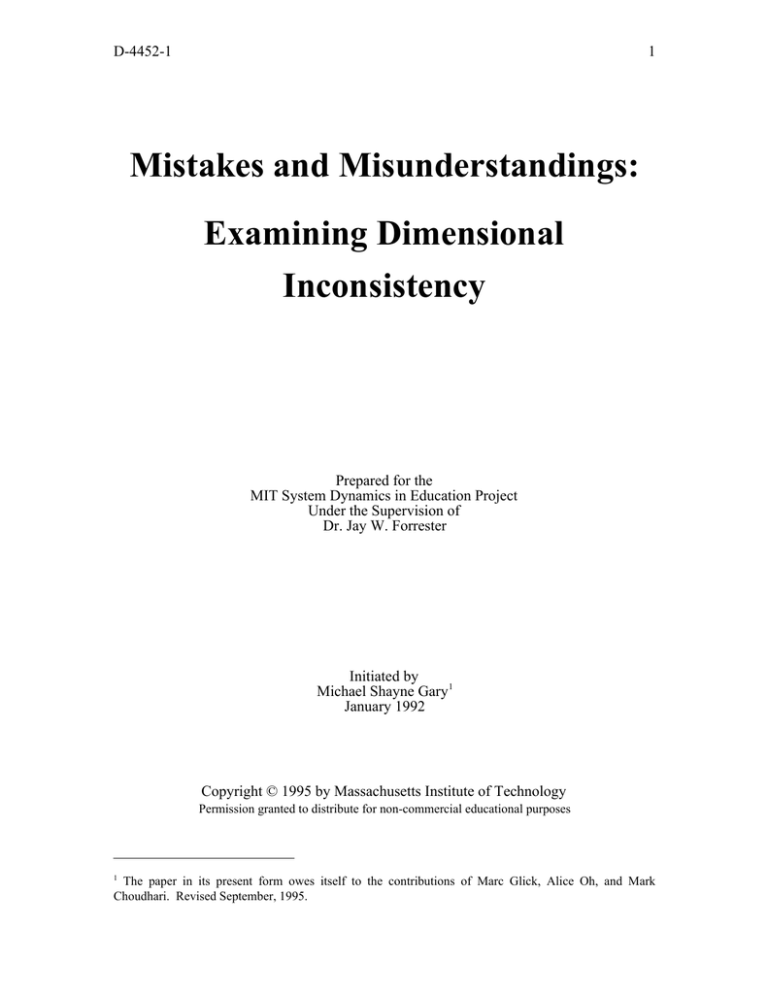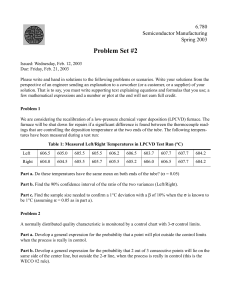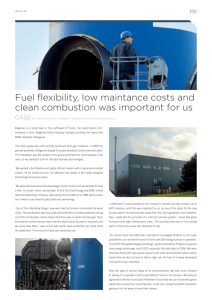Document 13624446
advertisement

D-4452-1 1 Mistakes and Misunderstandings: Examining Dimensional Inconsistency Prepared for the MIT System Dynamics in Education Project Under the Supervision of Dr. Jay W. Forrester Initiated by Michael Shayne Gary 1 January 1992 Copyright © 1995 by Massachusetts Institute of Technology Permission granted to distribute for non-commercial educational purposes 1 The paper in its present form owes itself to the contributions of Marc Glick, Alice Oh, and Mark Choudhari. Revised September, 1995. D-4452-1 3 1. THE SYSTEM Let us consider a familiar physical system, the thermostat-controlled furnace in a house. The mechanics of this system are simple; the furnace turns on or off depending on the temperature inside the house. Let us assume that the thermostat is set at 75°F. The furnace remains off as long as the temperature in the house stays above 75°F. When heat escapes the house through windows, walls, and doorways, the temperature in the house falls below 75°F, and the furnace turns on. After a while, the temperature reaches 75°F again, then the furnace shuts off until reactivated by another temperature drop. In short, the difference between the temperature within the house and the temperature set on the thermostat represents a temperature gap which controls whether the furnace is on or off. 2. A FIRST A TTEMPT TO MODEL THE SYSTEM Given the information we have about the system, let us begin with the model in Figure 1: House Temperature Heat Loss Heat Production Temperature Gap Goal Temperature Figure 1: Model of a thermostat-controlled furnace in a house 3. MISTAKES AND MISUNDERSTANDINGS A few questions often serve to identify mistakes made when modeling. Experience and patience teach the right questions to ask. STUDENT: TEACHER: So, Heat Production is a rate that flows into a stock of House Temperature. If that is the case, then what are the units of House Temperature? 4 D-4452-1 STUDENT: TEACHER: STUDENT: Degrees, of course, are the units of temperature. Degrees Celsius or Degrees Fahrenheit. Well, then what are the units of Heat Production? BTU’s per unit time or Calories per unit time; those are the standard units of Heat Production. The dimensions of the flow, Heat Production are: Heat / Time --Calories per minute or BTU’s per minute The dimensions of the stock, House Temperature are: Degrees --Degrees Celsius or Degrees Fahrenheit At this point, it should be clear that a mistake has been made. The units for the stock are not consistent with the units of the flow. Remember that a stock is something that accumulates over time, and the flows into and out of the stock are defined in stock units per time. Using House Temperature as a stock and Heat Production as an inflow is incorrect. Heat Production must flow into a stock of BTU’s or Calories, not degrees. Heat Production, in units of BTU’s per unit time or Calories per unit time, cannot be directly summed over time into units of Degrees. There must be a conversion from BTU’s or Calories to Degrees. The dimensions must be consistent for the equations to be correct, or the model is not valid. Now, we move to another, but related, question. Could temperature be used as a stock? No, stocks must correspond to a quantity that can accumulate in the real world. Temperature is not an accumulation. In the physical world, degrees do not accumulate into an amount of temperature. It is easy to confuse temperature for a stock when just beginning to model. To understand why temperature is not a stock, let’s do a few thought experiments. Experiment 1: Put a kettle with 1 inch of water on a kitchen range, and time how long it takes to boil. Now, do the same experiment with 4 inches of water. Would it take more, less, or the same amount of time to boil? It is obvious that it would take more time to boil. In both cases, the water in the kettle boils at 100°C. The difference in the time to boil different amounts of water is not because we are heating the kettle to different temperatures. The larger volume of water needs more time than the smaller volume of water to achieve the same boiling temperature of 100°C because we need more heat to raise a larger amount of water to the boiling temperature. D-4452-1 5 We are not adding degrees of temperature to the water in the kettle, we are adding heat. If the kitchen range were simply adding degrees to the water, it would take the same amount of time to raise the different quantities of water to the boiling temperature. This shows that temperature does not accumulate as a stock should. Experiment 2: Imagine a small electric room heater in a small room, and an identical heater in a large warehouse. We turn both the heaters on and measure the temperature in the small room and the large warehouse after a few hours. Which place will have the higher temperature? The small room will be warmer than the large warehouse. Why? If the electric heaters were merely adding degrees of temperature to the system, both the small room and the large warehouse should be at the same temperature. But they are not! This is because the heaters are adding heat and not temperature. It is heat that is accumulating in the room and not temperature. The large warehouse has a greater volume of air that is being heated than the small room. It takes longer to heat a larger volume of air than a small volume of air to a particular temperature. The addition of heat results in the increase in temperature. However, the rate at which temperature is increasing depends also on the amount of object that we are heating as we saw in Experiment 1. The temperature of a larger quantity will increase at a slower rate than a smaller quantity being heated by the same heat source. Also, the rate at which temperature increases depends on the physical properties of the object being heated. For example, the time it takes to heat a pan of oil to some temperature is not equal to the time it takes to heat the same amount of water to the same temperature. In the next section, you will see that these properties are lumped together in the form of a conversion factor that is used to translate from heat to temperature. We have seen that we cannot directly add a degree to the temperature of a system. To change the temperature one must add heat to the system. The final result of this distinction is that the property of an object, identified as temperature, does not constitute an accumulation. One cannot change temperature by just adding or taking away degrees. However, one can add heat to a system, which would subsequently result in a temperature change. Therefore, heat should be the stock in the system because heat is the quantity that can flow and accumulate. 6 D-4452-1 4. OVERCOMING OUR MISTAKES AND MISUNDERSTANDINGS In Figure 2 is the corrected formulation of the thermostat-controlled furnace model, with the information given so far. Heat in House Heat Production Heat Loss House Temperature Temperature Gap Conversion Factor Goal Temperature Figure 2: Corrected model of a thermostat-controlled furnace in a house The change to the model defines the physical situation more accurately. The furnace produces heat, which fills the house with heat. By changing the amount of heat in the house, one can change the temperature in the house. Then one can calculate the temperature of the house from the total heat in the house using the conversion factor. 2 The temperature gap drives the heat production, just as described for the model in Figure 1. 5. KEY LESSONS 1. All equations must be defined in units that maintain dimensional consistency. Do not let an unclear mental model lead you into defining relationships that are dimensionally impossible. 2. Stocks must correspond to quantities that can accumulate in the real world. In choosing the stocks for your model, think of the quantities that are accumulating and/or draining in the system. 2 For the more curious mind: The conversion factor is based upon physical properties specific to the system. These properties are the volume of the system, the specific heat capacity of the system, and the density of the system. If you are interested, you can find a more detailed treatment of these properties in any high school Physics text book.






